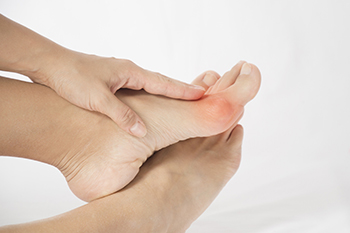Items filtered by date: February 2023
Athlete’s Foot Affects More Than Athletes

Though its name would imply the skin condition known as athlete’s foot is specific to athletes, that is not the case. Anyone can get this fungal infection. It is said to be more common in specific geographic regions, and tends to impact the elderly who have a weakened immune system or other conditions affecting the lower leg. Athlete’s foot is also referred to as tinea pedis or ringworm of the foot. It is generally characterized by flaking, itching, and a burning sensation between the toes and the skin on the feet. Sometimes the skin will appear to be blistered and may crack. This condition comes from a moist environment combined with a fungus called Trichophyton. Athlete’s foot is highly contagious and can spread through physical contact or from sharing towels, sheets, socks, and shoes. It is an infection that can also spread to the toenails causing them to become discolored, brittle, and ragged. If you believe you have athlete’s foot, it is suggested that you see a podiatrist for a proper diagnosis and treatment.
Athlete’s Foot
Athlete’s foot is often an uncomfortable condition to experience. Thankfully, podiatrists specialize in treating athlete’s foot and offer the best treatment options. If you have any questions about athlete’s foot, consult with Kimberly Woodard, DPM from Pinnacle Foot and Ankle Centers, LLC . Our doctor will assess your condition and provide you with quality treatment.
What Is Athlete’s Foot?
Tinea pedis, more commonly known as athlete’s foot, is a non-serious and common fungal infection of the foot. Athlete’s foot is contagious and can be contracted by touching someone who has it or infected surfaces. The most common places contaminated by it are public showers, locker rooms, and swimming pools. Once contracted, it grows on feet that are left inside moist, dark, and warm shoes and socks.
Prevention
The most effective ways to prevent athlete’s foot include:
- Thoroughly washing and drying feet
- Avoid going barefoot in locker rooms and public showers
- Using shower shoes in public showers
- Wearing socks that allow the feet to breathe
- Changing socks and shoes frequently if you sweat a lot
Symptoms
Athlete’s foot initially occurs as a rash between the toes. However, if left undiagnosed, it can spread to the sides and bottom of the feet, toenails, and if touched by hand, the hands themselves. Symptoms include:
- Redness
- Burning
- Itching
- Scaly and peeling skin
Diagnosis and Treatment
Diagnosis is quick and easy. Skin samples will be taken and either viewed under a microscope or sent to a lab for testing. Sometimes, a podiatrist can diagnose it based on simply looking at it. Once confirmed, treatment options include oral and topical antifungal medications.
If you have any questions, please feel free to contact our office located in Port St. Lucie, FL . We offer the newest diagnostic and treatment technologies for all your foot care needs.
Plantar Warts Can Be Treated!
Is Working On Your Feet Bad for You?

Many people in all employment lines spend most of the workday standing on their feet. Many workers of this kind often wonder if working on one’s feet all day can be bad for you or yield detrimental health consequences. It is important to note that merely being in a natural, standing position is not damaging in and of itself. However, the answer becomes more complicated if the employee is essentially working in that position all day long. As a result of this, the employee might develop certain foot complications, such as sore feet, muscular fatigue, and other health conditions. Assembly-line workers and cashiers are examples of workers that this might impact. It is suggested that you contact a podiatrist today if any of this applies to you. This licensed foot doctor will be able to answer any questions you might have and address your problems.
While working on the feet, it is important to take the proper care of them. For more information about working on your feet, contact Kimberly Woodard, DPM from Pinnacle Foot and Ankle Centers, LLC . Our doctor will treat your foot and ankle needs.
Working on Your Feet
Standing on your feet for long periods of time can cause stress and pain in your feet. Your whole body may experience change in terms of posture, back pain, bunions, callouses and or plantar warts. There are ways to avoid these conditions with proper foot care, smart choices and correct posture.
Positive Changes
Negative heeled shoe – Choosing this shoe type places the heel slightly lower than the ball of the foot. These are great for overall foot health. Find shoes that fit you correctly.
Go barefoot – Our feet were not designed to be enclosed for all hours of the day. Try to periodically expose your feet to air.
Eliminate Pain
Foot Exercises – Performing simple exercises, incorporating yoga and doing stretches are beneficial. This will allow increased blood flow to the area and muscles of the foot.
Achilles tendon – Stretching the foot out flat on the floor will relax the calf muscles and tendon. These exercises can be performed almost anywhere. Make sure you add these exercises to your daily regimen.
With a little bit of this information and knowing more about foot health, you will notice changes. Foot stretches and proper footwear will help with pain and prevent further issues.
If you have any questions please feel free to contact our office located in Port St. Lucie, FL . We offer the newest diagnostic and treatment technologies for all your foot and ankle needs.
Pregnancy and ICP

Many women who are pregnant, or who are trying to become pregnant, may not already be familiar with ICP and what it means. Essentially, ICP, medically known as intrahepetic cholestasis of pregnancy, is a particular kind of liver condition that may develop during a woman’s pregnancy. As a result of the ICP, severe itching can be experienced on parts of the body, such as the soles of the feet. Interestingly, the itching as a result of ICP can be accompanied by a rash of some sort on the skin, although this is not always the case. If you are pregnant or are trying to become pregnant, consider contacting a podiatrist today. A podiatrist is a medical professional that specializes in foot health, and this doctor would be able to help you navigate the many changes that take place in the feet during pregnancy.
Pregnant women with swollen feet can be treated with a variety of different methods that are readily available. For more information about other cures for swollen feet during pregnancy, consult with Kimberly Woodard, DPM from Pinnacle Foot and Ankle Centers, LLC . Our doctor will attend to all of your foot and ankle needs.
What Foot Problems Can Arise During Pregnancy?
One problem that can occur is overpronation, which occurs when the arch of the foot flattens and tends to roll inward. This can cause pain and discomfort in your heels while you’re walking or even just standing up, trying to support your baby.
Another problem is edema, or swelling in the extremities. This often affects the feet during pregnancy but tends to occur in the later stages.
How Can I Keep My Feet Healthy During Pregnancy?
- Wearing orthotics can provide extra support for the feet and help distribute weight evenly
- Minimize the amount of time spent walking barefoot
- Wear shoes with good arch support
- Wear shoes that allow for good circulation to the feet
- Elevate feet if you experience swelling
- Massage your feet
- Get regular, light exercise, such as walking, to promote blood circulation to the feet
If you have any questions please feel free to contact our office located in Port St. Lucie, FL . We offer the newest diagnostic and treatment technologies for all your foot and ankle needs.
Skiing With Bunions

Bunions are a particular foot affliction that can alter the shape of the feet. Specifically, this condition makes it so a bony bump or protrusion develops on the side of the big toe (or, less commonly, the pinky toe). Sometimes, individuals living with bunions have a more difficult time engaging in physical activity due to the condition. Some patients are interested to know whether or not they can still ski even if they develop bunions. If the bunions are a source of pain, then squeezing them into a tight pair of ski boots might not always be an advisable option. This is compounded by the fact that skiing, especially downhill, can exert pressure on the toes. If you are someone that likes skiing and are currently struggling with bunions, contact a podiatrist to schedule an appointment today.
If you are suffering from bunions, contact Kimberly Woodard, DPM of Pinnacle Foot and Ankle Centers, LLC . Our doctor can provide the care you need to keep you pain-free and on your feet.
What Is a Bunion?
A bunion is formed of swollen tissue or an enlargement of boney growth, usually located at the base joint of the toe that connects to the foot. The swelling occurs due to the bones in the big toe shifting inward, which impacts the other toes of the foot. This causes the area around the base of the big toe to become inflamed and painful.
Why Do Bunions Form?
Genetics – Susceptibility to bunions are often hereditary
Stress on the feet – Poorly fitted and uncomfortable footwear that places stress on feet, such as heels, can worsen existing bunions
How Are Bunions Diagnosed?
Doctors often perform two tests – blood tests and x-rays – when trying to diagnose bunions, especially in the early stages of development. Blood tests help determine if the foot pain is being caused by something else, such as arthritis, while x-rays provide a clear picture of your bone structure to your doctor.
How Are Bunions Treated?
- Refrain from wearing heels or similar shoes that cause discomfort
- Select wider shoes that can provide more comfort and reduce pain
- Anti-inflammatory and pain management drugs
- Orthotics or foot inserts
- Surgery
If you have any questions, please feel free to contact our office located in Port St. Lucie, FL . We offer the newest diagnostic and treatment technologies for all your foot care needs.

